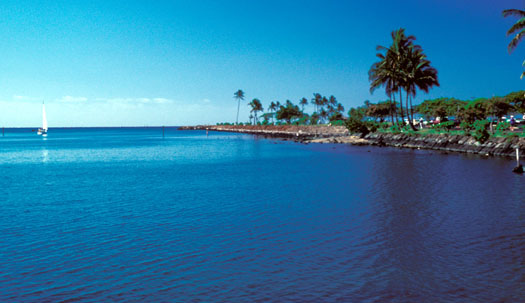
Magic Island is a mostly man-made peninsula that juts out into the ocean at the eastern end of Ala Moana Beach Park on Oahu. It is bordered on its eastern side by a dredged boat channel that leads into the Ala Wai Yacht Harbor. It is also the pathway to the ocean via the Ala Wai Canal for most of the rain that falls in several Honolulu valleys, including Manoa and Palolo valleys.

Conditions here could be pretty miserable. Mountain rainfall, of which Hawaii gets a lot, flows down through the valleys, collecting in streams that feed into the canal. In medium to heavy rainstorms, this runoff looks like rusty red or brown mud filling the canal, which would then flow out the boat channel. Also, considerable trash and who-knows-what-else collects in the harbor and often flows out with the runoff. True, much of this runoff seems to remain in the top meter or so of water, and the water might be clearer once you get down through that layer. Still, I tried to do my diving here only if it had not rained much for the previous few days. Even so, I still sometimes shudder to think of all the hours I soaked in there.
I can no longer recall why I was willing to try it the first time. But once I did, there was no question of not going back. A 5 to 10m high wall between the reef and the dredged-out channel was silty but loaded with life. There were lots of sponges and bryozoans and some soft corals, quite a few feather duster worms and lots of nudibranchs.
On a typical dive here, I'd park in the Magic Island parking lot, usually early in the morning before the crowds arrived to go to the beach. But there was still activity. Buses would pull up and offload gaggles of tourists, who would take a few pictures before crowding back onto the bus and proceeding to the next stop. I'd get a few odd looks while suiting up in my dive gear, and a fair number of tourists went home with photos of a fully clad diver posed next to their friends or family members (look at the crazy haole!). Once geared up, I'd walk out toward the outer edge of the Magic Island peninsula to where a rocky breakwater extended out at an angle 10 meters or so towards the channel. Just beyond this was a small rocky beach used by surfers to enter and exit the water. They would cross the channel to surf the break on the other side.
I'd get in the water at this beach and swim the 10 or so meters over shallow reef to the edge of the channel. The top of the channel here was a meter or two deep, but as you proceeded back in toward the island, the top got shallower. I would then slowly search up and down along the wall until my tank ran dry, at which time I would usually be approximately back to even with the parking lot, where I would exit.
Being the edge of a boat channel, there were the frequent sounds of boats motoring past. I wasn't too worried about these, since when I heard engines I just made sure to stay deep enough to avoid any propellers just in case they meandered out of the marked channel. Silent sailboats, however, were a bit of a concern. Several times while at the top of the channel, I'd run across spots where boats had hit the reef, leaving a meter or two scraping of bottom paint and broken rock. I suppose some sailor was trying to tack his way in and went a little too far over to the edge.
But the nudis here were worth it. During the time I was diving here, the most common and obvious species was the large Hypselodoris imperialis, although they vanished sometime in 1983. This was also the best place I ever found for a number of other species, including Goniobranchus albopunctatus, Goniobranchus decorus, Hypselodoris bertschi, Thorunna kahuna, Goniobranchus albopustulosus, Goniobranchus verrieri, Hypselodoris maridadilus, and Bermudella pellucida.
I have not been back since 1985, but years later, I sent a friend back there to look. He reported no Hypselodoris imperialis and not many of these other species, but lots of Tambja morosa, a species I never saw there. Given the level of environmental pressures on this site, I suppose it is not surprising that the fauna changes.
I hear rumors that the area is now off limits to divers. That would be sad if true.
Close tab when finished.